Which Monmouth and Ocean bridges need to be fixed? These 24 are on the list
In early March, the Route 71 bridge linking Belmar and Avon stopped opening to boat traffic. The unexpected closure due to a mechanical failure adds the bridge to a list of bridges in New Jersey with poor ratings that are proposed to be monitored more frequently, rehabilitated or replaced.
Of the 749 bridges in Monmouth and Ocean counties, 59 bridges have a poor rating according to the U.S. Department of Transportation’s National Bridge Inventory. Eight out of 241 Ocean County bridges, or 3.3%, and 51 out of 508 Monmouth County bridges, or 10%, are rated poor.
According to the New Jersey Department of Transportation spokesman Steve Schapiro, every bridge in the state 20 feet or longer is inspected “at a minimum of every two years.” The average bridge age is 55 years.
“While we are making progress repairing bridges in poor condition, the condition of other bridges may worsen,” he wrote in an email.
Are modern bridges better? Baltimore's Key Bridge, opened in 1977, had few ship defenses.
“If the inspectors ever come across a structure that we determine to be unsafe, NJDOT will close either a lane or the entire bridge to make emergency repairs and would not hesitate to take the bridge out of service,” he wrote.
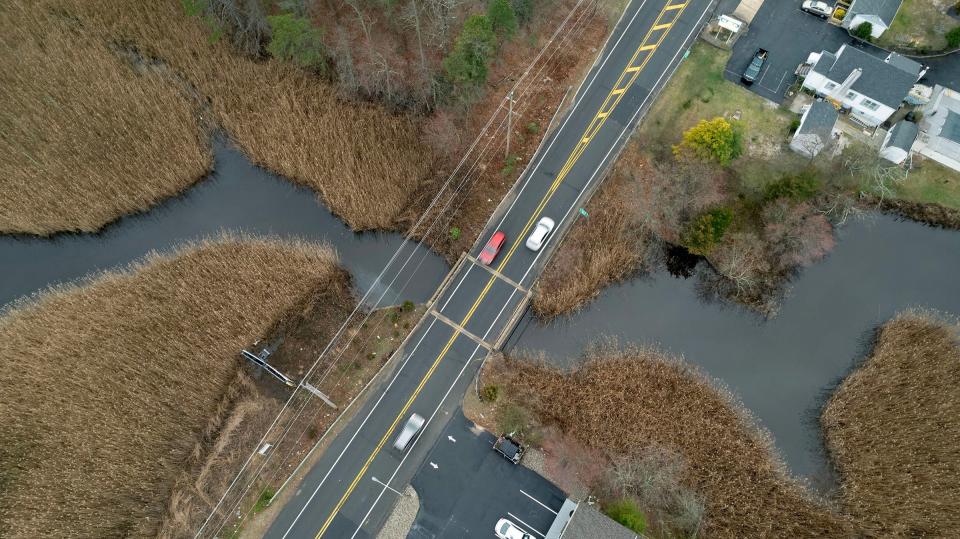
See an interactive map of all bridge ratings: data.app.com/bridge/new-jersey/34/
Road work coming: Check out the big road projects planned for Monmouth and Ocean counties through the 2020s
The NJDOT has a $85 million budget for emergency bridge repairs. In fiscal year 2024, the department’s Capital Program allocated $893 million for state and local bridges. And in 2016, the NJDOT increased its Local Bridges Fund from $25 million to $47.3 million a year. This fund allows counties to repair bridges that are under their jurisdiction.
The federal Infrastructure Investment and Jobs Acts, passed in 2021, allocated $1.14 billion in federal bridge funding money to New Jersey over five years, according to Schapiro. “So far, most of these funds have been used for project design," he wrote, "and in later years will help fund construction.”
Schapiro wrote that funding has improved over the past decade. He wrote that in 2011, 9.2%, or 605 of the 6,602 bridges then in the state were in poor condition. Currently, 5.9%, or 404 of 6,797 bridges, are in poor condition statewide.
He wrote that bridges are prioritized based of “many factors including, but not limited to, bridge condition, traffic volume, crash rates, regional needs and funding availability.”
Schapiro noted that a challenge for New Jersey is that the state has “some of the heaviest truck traffic in the nation.” He wrote that the weather with snow, ice and temperature fluctuations can cause wear and tear, especially on bridge decks.
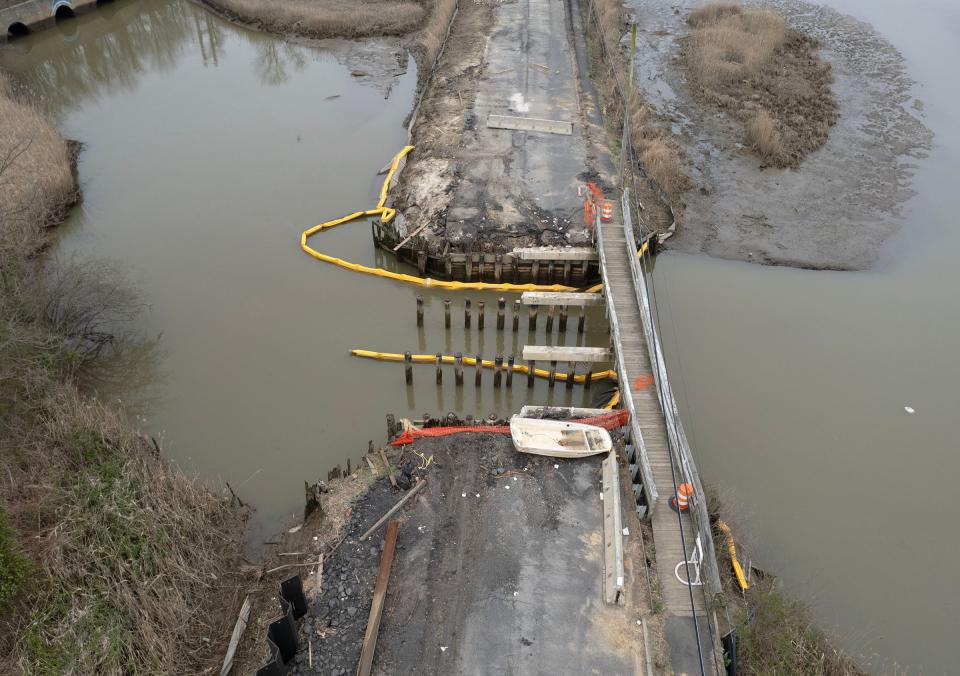
'Sleeping giant': NJ Transit eyes affordable housing, sidewalks for Route 9 bus commuters
How bridges are rated?
Bridges are rated on two scales: sufficiency ratings, rated on a scale of zero to 100, and bridge component condition ratings, rated on a scale of zero to nine per component.
According to Schapiro, for a bridge to qualify for federal bridge replacement funds, bridges must have a sufficiency rating of under 50. Federal rehabilitation funding requires that a bridge have a sufficiency rating of under 80.
Bridge components include: the deck or surface of the bridge; the superstructure, or the upper part of the bridge that absorbs the carrying weight of the bridge; the substructure, or part of the bridge between the superstructure and foundation; and the foundation or the piles in the ground that support the bridge.
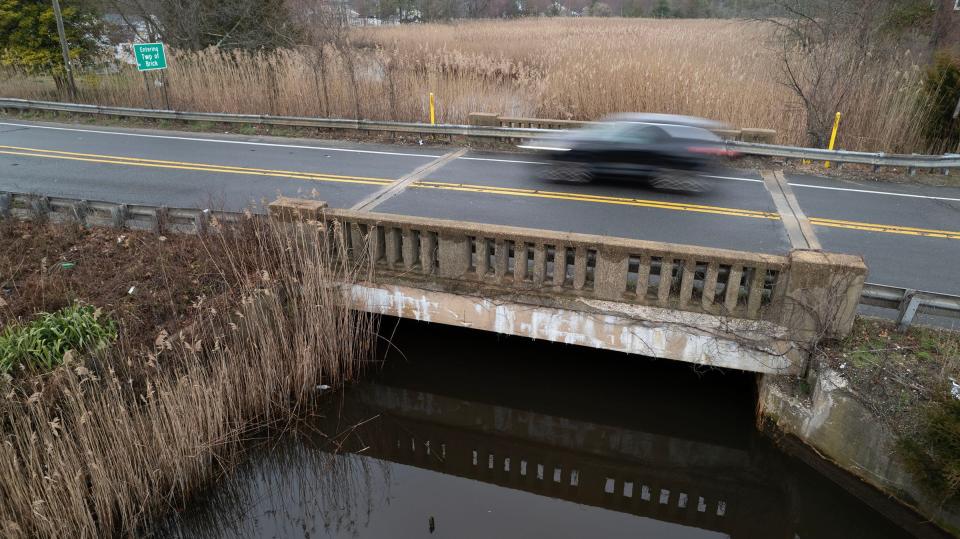
If all the components are rated between seven and nine, the bridge would be considered in good condition. If the lowest-rated component is between five and eight, the bridge would be considered in fair condition. If any of the components are rated four and below, the bridge would be considered in poor condition. Components rated below a three require more frequent monitoring, load restrictions or fixes.
According to the USDOT’s Specifications for the National Bridge Inventory, the rating of four, or poor, implies widespread moderate or isolated major defects in which the performance of the component is affected; three, or serious, implies major defects in which the strength or performance of the component is seriously affects; two, or critical, implies major defects in which the component is severely compromised; one (imminent failure) and zero (failed) would require the bridge to be closed.
The National Bridge Inventory also rates the scour condition, which determines whether sediment erosion could cause the foundation to become unstable.
Jersey Shore roads: Lakewood car crashes have jumped 69% in 20 years. So what are they going to do about it?
Of the 59 bridges in Monmouth and Ocean counties that have a poor rating, 24 bridges are currently being replaced or are under consideration for replacement or rehabilitation by the state or county. Ten bridges have recently been replaced or rehabilitated, but their status has not been updated.
Here they are:
Oceanic Bridge, also known as Bingham Avenue Bridge, in Rumson and Middletown
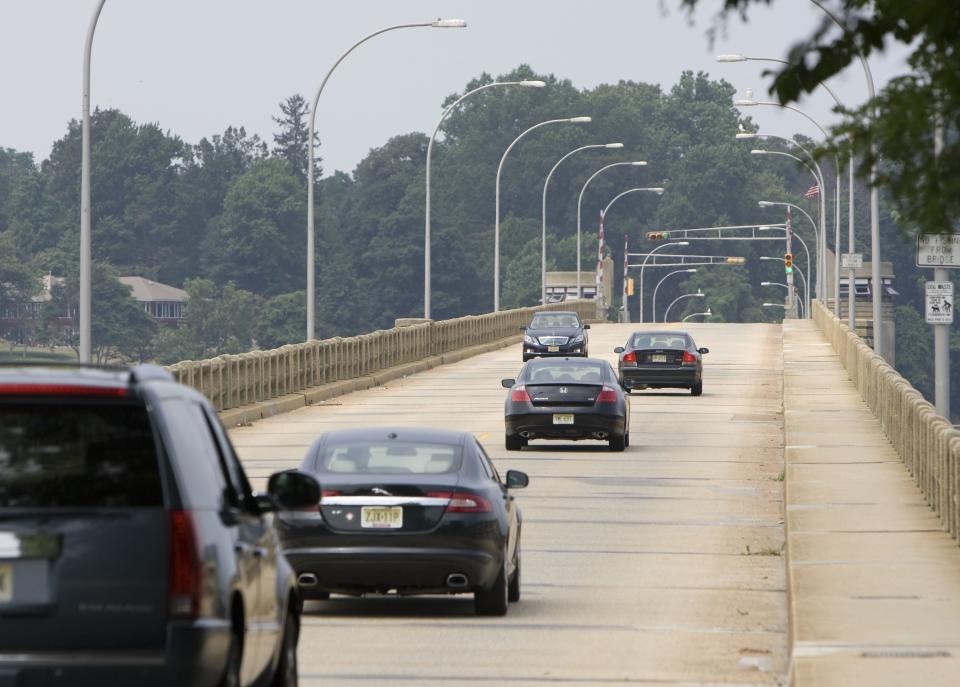
Lowest-rated components: Superstructure, 3 or serious, and substructure, 4 or poor
The Oceanic Bridge was built in 1939 and restructured in 1993. In 2015, a Bridge Re-evaluation and Structural Inventory and Appraisal report found that the bridge was in critical condition. The superstructure had “heavy rust throughout steel members with small corrosion holes in girder webs.” Some rivet heads, bottom flanges of the floor beams, girders, floor beams and cantilever brackets had rusting that resulted in “section loss.” And “several concrete approach spans … exhibit large spalls with exposed rebar and cracking in T-beams.” The substructure had “wide cracking and deep spalls (portions that are chipped off) with exposed and severely rusted reinforcing steel.” Its timber piles had severe decay, which required steel jackets to be installed around them. The NJDOT project is currently slated for preliminary engineering, which could recommend a plan that would replace the bridge. A project completion date has not been posted by the NJTPA.
In 2021, it had an average daily traffic of 15,030 vehicles with 4% truck traffic. In 2041, the daily traffic is expected to rise to 18,040 vehicles.
Total estimated project cost according to the NJTPA: $184.4 million.
Sea Bright Bridge in Sea Bright and Rumson
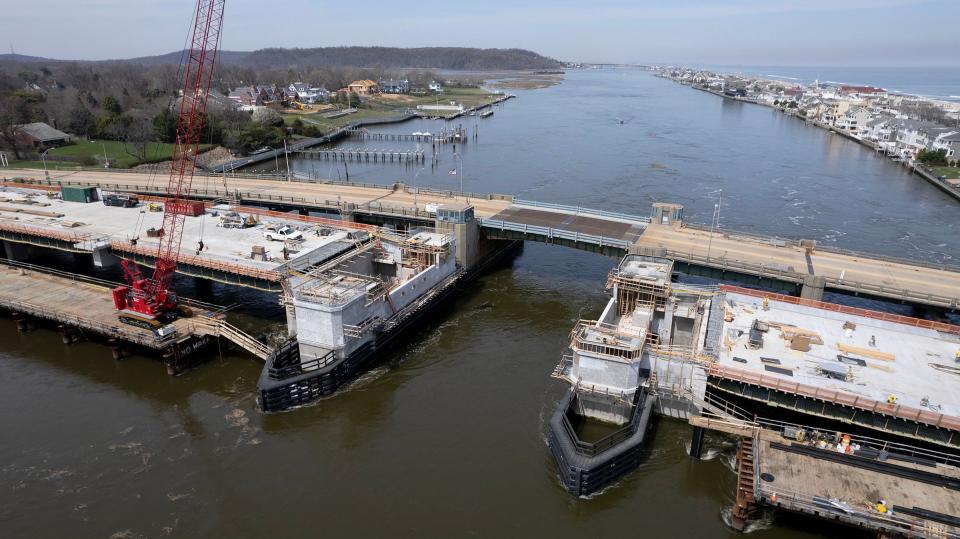
Lowest-rated components: Superstructure, 4 or poor
The Sea Bright Bridge was built in 1950 and a new bridge is currently undergoing construction next to the old bridge. The new bridge is expected to be completed by the spring of 2025. When the new bridge is completed, the old bridge will be demolished. Currently, the bridge has two lanes and an open grate section that rumbles. The new bridge will have two lanes going toward Sea Bright and one lane going toward Rumson. Its deck will be concrete, which will reduce noise and improve cyclist safety. The drawbridge will have three backups: a motor, a generator and a natural gas-powered engine.
The scour condition was rated a 3, which means that the bridge has major scour that could seriously affect the strength and stability of the bridge, according to USDOT’s Specifications for that National Bridge Inventory handbook.
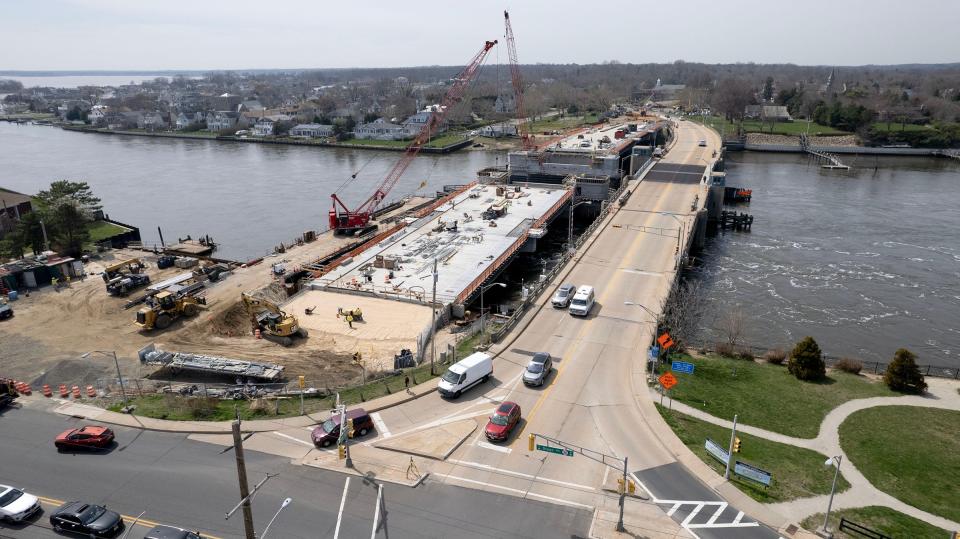
In 2021, it had an average daily traffic of 11,004 vehicles with 4% truck traffic. In 2041, the daily traffic is expected to rise to 13,204 vehicles.
Construction cost according to R.E. Pierson Construction Co.: $107.5 million.
Brielle Road bridge over Glimmer Glass and Green Avenue bridge over Debbies Creek in Brielle and Manasquan
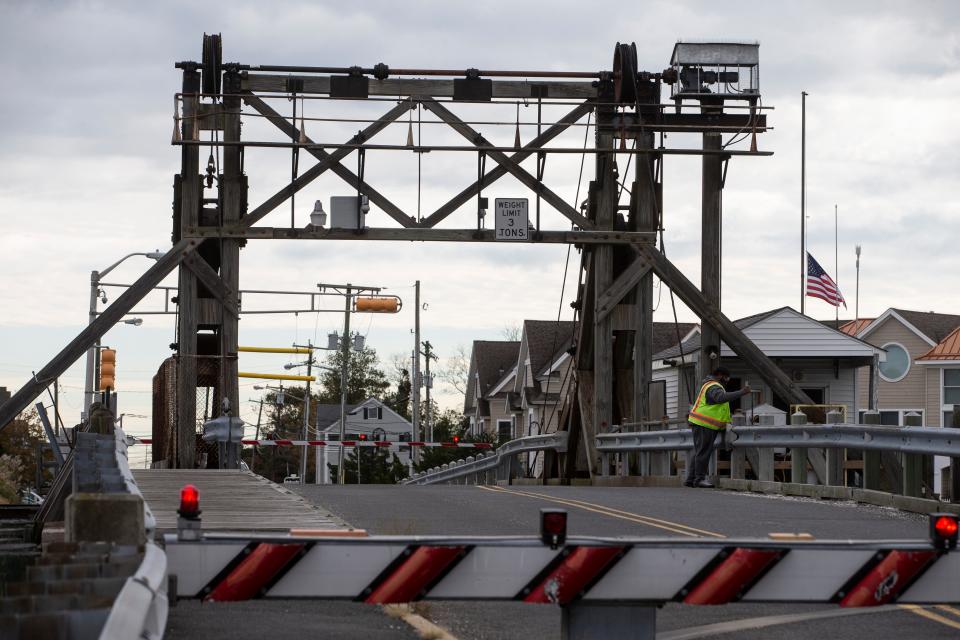
Lowest-rated components: Brielle Road, superstructure, 4 or poor; Green Avenue, substructure, 4 or poor
Brielle Road, which includes the Glimmer Glass Bridge, was built in 1889 and reconstructed in 1950. The Green Avenue bridge was built in 1946. The Glimmer Glass Bridge went under emergency repairs after it received a sufficiency rating of 2 out of 100 in 2013. After the repairs, it received a 10.1 sufficiency rating. An NJDOT project that is under preliminary engineering would rehabilitate or replace the bridges.
More on the bridge: Glimmer Glass Bridge project rolls toward replacement as preservationists fight on
In 2021, the Brielle Road bridge had an average daily traffic of 7,405 vehicles with 1% truck traffic. In 2041, the daily traffic is expected to rise to 8,885 vehicles. The Green Avenue bridge had an average daily traffic of 2,196 vehicles with 1% truck traffic in 2021. In 2041, the daily traffic is expected to rise to 2,680 vehicles.
Total estimated project cost according to the NJTPA: $35.3 million.
Route 71 bridge over NJ Transit railroad in Deal and Ocean Township
Lowest-rated components: Substructure, 4 or poor
Built in 1917 and reconstructed in 1937, the NJDOT project would add a center left turn lane, shoulder and sidewalk. It would reduce the four lanes to two on each side and widen the bridge in anticipation of future NJ Transit lines. It would also close the intersection of Elberon Boulevard into a cul-de-sac. The project is in its design phase and is estimated to be completed in the fall 2030.
In 2022, it had an average daily traffic of 15,828 vehicles with 4% truck traffic. In 2042, the daily traffic is expected to rise to 18,994 vehicles.
Total estimated project cost according to the NJTPA: $33 million
Route 166 bridges in Toms River and South Toms River
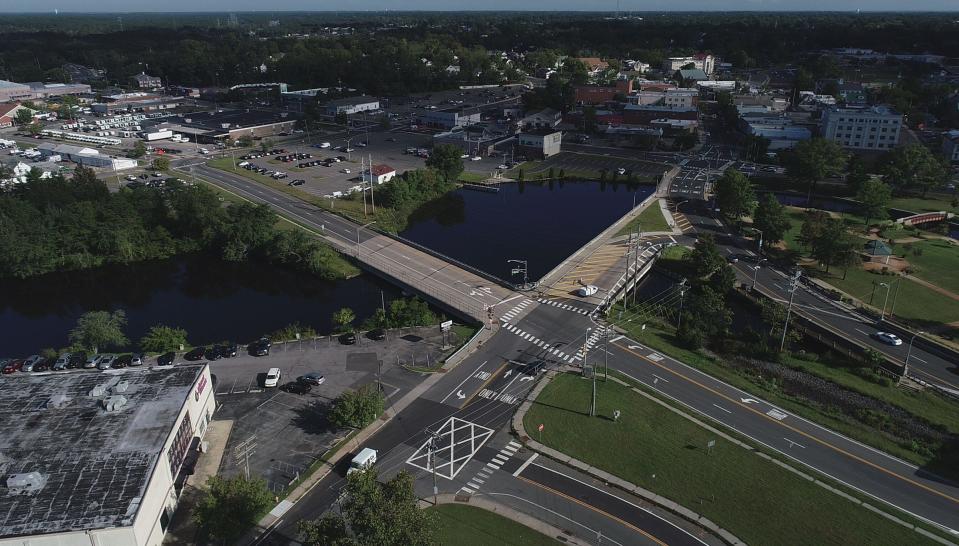
Lowest-rated components: Bridge closest to Cedar Cove Marina, substructure, 3 or serious; bridge closest to Huddy Park, deck, superstructure and substructure, 4 or poor
Built in 1928, both bridges are in need of repair. In 2015, NJDOT closed one lane of Route 166 for emergency repairs after it found “deterioration on the underside of the bridge deck has increased at an alarming rate with concrete falling into the river,” according to a news release. Both bridges have a scour condition rated a 3, meaning major scour that affect the strength or stability of the bridge. Bridge replacement could be completed by spring 2027.
In 2020, the bridge closest to Cedar Cove Marina had an average daily traffic of 12,985 vehicles with 4% truck traffic. In 2040, the daily traffic is expected to rise to 15,860 vehicles. In 2022, the bridge closest to Huddy Park had an average daily traffic of 26,921 vehicles with 4% truck traffic. In 2040, the daily traffic is expected to rise to 32,305 vehicles.
Total estimated project cost according to the NJTPA: $32.6 million
Corlies Avenue Bridge over Deal Lake in Allenhurst and Ocean Township
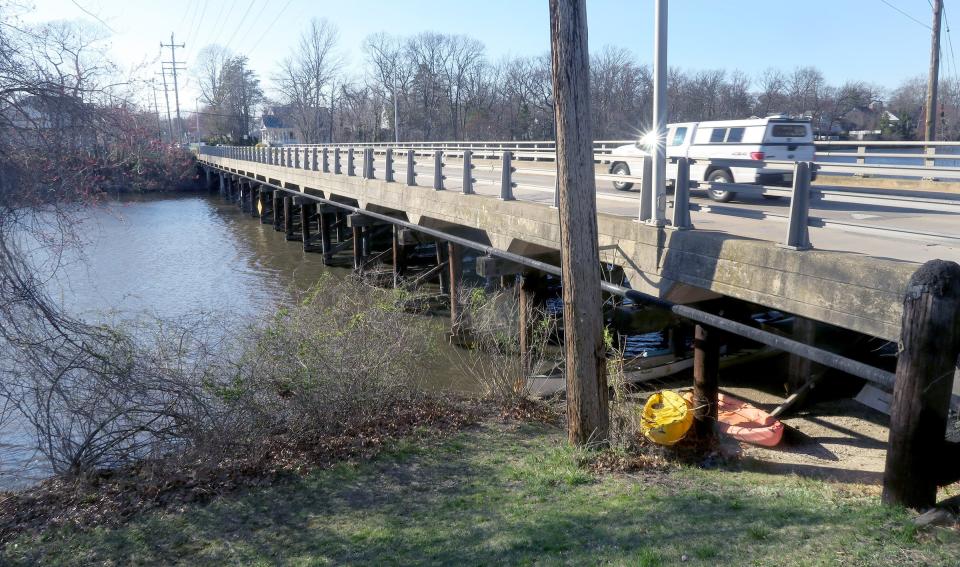
Lowest-rated components: Deck, 4 or poor
Built in 1971 and reconstructed in 1976, NJDOT have flagged both the deck and the substructure as in need of improvements. The substructure, which is rated a 5 or fair, according to the National Bridge Inventory, has “weathering to the timber piles and pile cap at all pile bents and severe heart rot.” The deck’s poor rating is due to potholes, cracks and “large, deep spalls with exposed and corroded rebar in the underside of the deck.” The project is currently under preliminary engineering for improvements. An estimated project completion date has not been posted by the NJTPA.
In 2021, it had an average daily traffic of 6,172 vehicles with 4% truck traffic. In 2041, the daily traffic is expected to rise to 7,531 vehicles.
Total estimated project cost according to the NJTPA: $32 million.
Aberdeen Road bridge over Matawan Creek in Matawan

Lowest-rated components: Substructure, 3 or serious
Built in 1944, the bridge was reconstructed in 1961. The county is now replacing the bridge.
In 2021, the bridge had an average daily traffic of 9,570 vehicles with 1% truck traffic. In 2041, the daily traffic is expected to rise to 11,485 vehicles.
Construction cost according to the Monmouth County Purchasing Divison: $21.7 million.
Union Hill Road over Route 9 in Marlboro
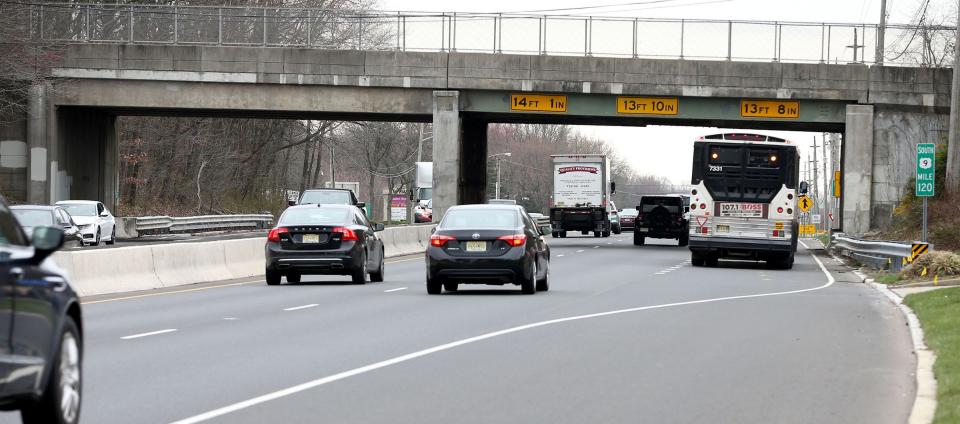
Lowest-rated components: Deck, 4 or poor
The bridge was built in 1940 and reconstructed in 1997. The bridge’s deck has a poor rating due to “inadequate deck geometry and vertical underclearance.” The bridge is proposed to be replaced and the new bridge will be raised to comply current design standards and the sidewalks will comply with the ADA. The NJDOT proposes to replace the bridge, which is in the design phase. The project is estimated to be completed in early 2029.
In 2021, the bridge had an average daily traffic of 18,635 vehicles with 4% truck traffic. In 2041, the daily traffic is expected to rise to 22,360 vehicles.
Total estimated project cost according to the NJTPA: $21.8 million.
Route 33 Business bridge over Conrail Freehold Secondary Branch in Freehold
Lowest-rated components: Deck, 3 or serious
Built in 1925, the NJDOT project that is currently in its design phase, would replace the “structurally deficient” bridge.
In 2022, the bridge had an average daily traffic of 14,438 vehicles with 4% truck traffic. In 2042, the daily traffic is expected to rise to 17,618 vehicles.
Total estimated project cost according to the NJTPA: $16 million.
School House Road over Route 35 in Brielle
Lowest-rated components: Deck, 4 or poor
Built in 1931, the NJDOT is proposing to replace the bridge. It is currently in its design phase and is estimated to be completed in spring 2029.
In 2021, the bridge had an average daily traffic of 1,520 vehicles with 1% truck traffic. In 2041, the daily traffic is expected to rise to 1,824 vehicles.
Total estimated project cost according to the NJTPA: $12.5 million.
Chadwick Beach Island Bridge over Barnegat Bay in Toms River
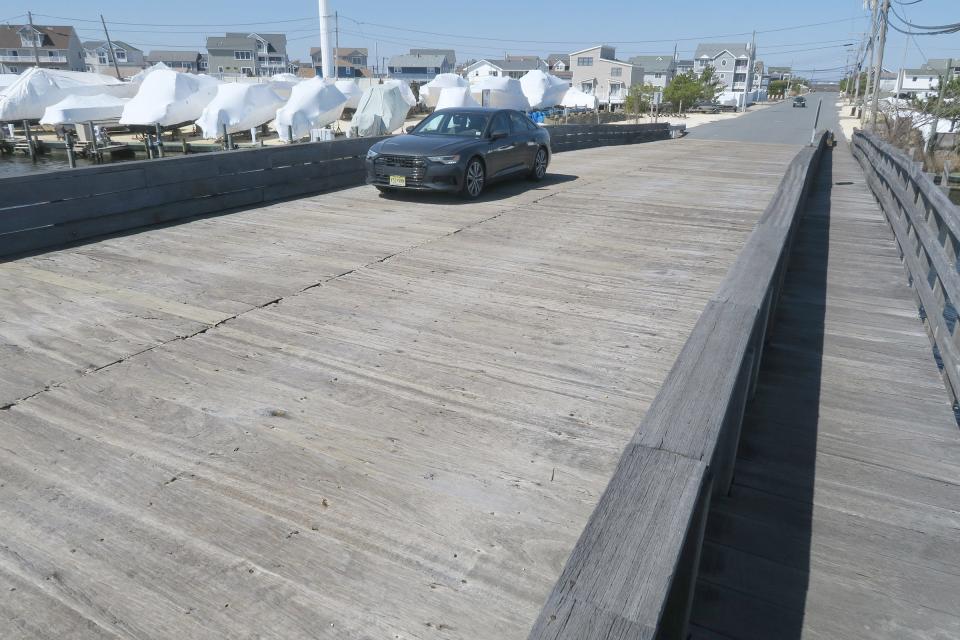
Lowest-rated components: Substructure, 4 or poor
The bridge, the only connection between the Chadwick Beach Island residential community and the main island, was built in 1931 and reconstructed in 1955. Its substructure was given a poor rating due to most of the timber bulkheads exhibiting “severe section loss and in places is visibly compromised.” The NJDOT proposes to replace the bridge. It is currently in the design phase and is estimated to be completed in 2029.
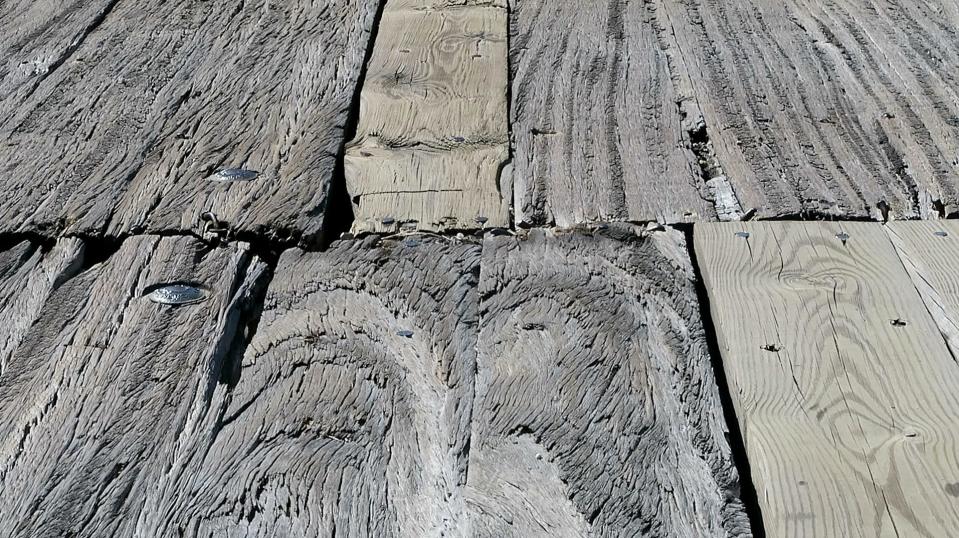
In 2022, the bridge had an average daily traffic of 1,193 vehicles with 1% truck traffic. In 2042, the daily traffic is expected to rise to 1,431 vehicles.
Total estimated project cost according to the NJTPA: $12.4 million.
Route 34 bridge over Big Brook in Colts Neck
Lowest-rated components: Deck, superstructure and substructure, 4 or poor
Built in 1930, it also has a scour condition of 3 or major scour, meaning that the strength and stability of the bridge is seriously affected. The NJDOT intends to replace the bridge. The project is currently in preliminary engineering and is intended to be completed by the end of 2028.
In 2021, the bridge had an average daily traffic of 16,077 vehicles with 4% truck traffic. In 2041, the daily traffic is expected to rise to 18,283 vehicles.
Total estimated project cost according to the NJTPA: $11.4 million.
Route 88 bridge over Beaver Dam Creek in Brick
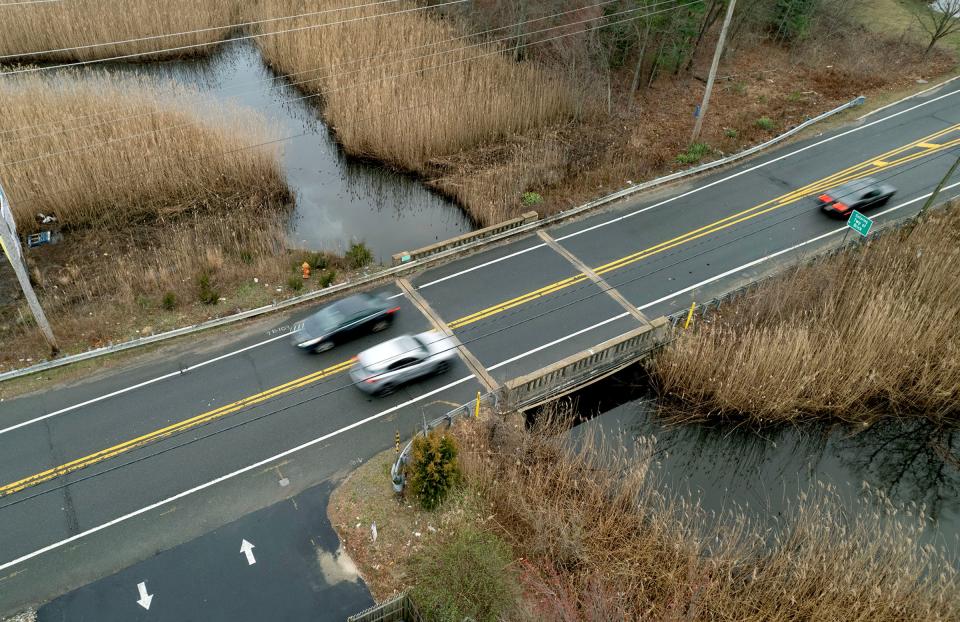
Lowest-rated components: Superstructure, 4 or poor
Built in 1923, the deck geometry has “substandard cross slopes (and) shoulder widths.” The NJDOT project would replace the bridge and add sidewalks. It is estimated to be completed in summer 2027.
In 2022, the bridge had an average daily traffic of 20,200 vehicles with 4% truck traffic. In 2042, the daily traffic is expected to rise to 24,260 vehicles.
Construction cost according to the engineering firm Jacobs: $11 million.
Jersey Shore roads: It's getting safer to drive around Brick, but here's why drivers still feel stressed
Allaire Road bridge over Mingamahone Brook in Howell

Lowest-rated components: Deck, 4 or poor
Built in 1926 and reconstructed in 1960. In addition to the deck rating, the scour was rated a 3, meaning major scour that affect the strength or stability of the bridge.
In 2021, the bridge had an average daily traffic of 4,661 vehicles with 3% truck traffic. In 2041, the daily traffic is expected to rise to 5,687 vehicles.
Construction cost according to the Monmouth County Purchasing Division: $10.4 million.
Route 35 bridge over the north branch of Wreck Pond in Wall
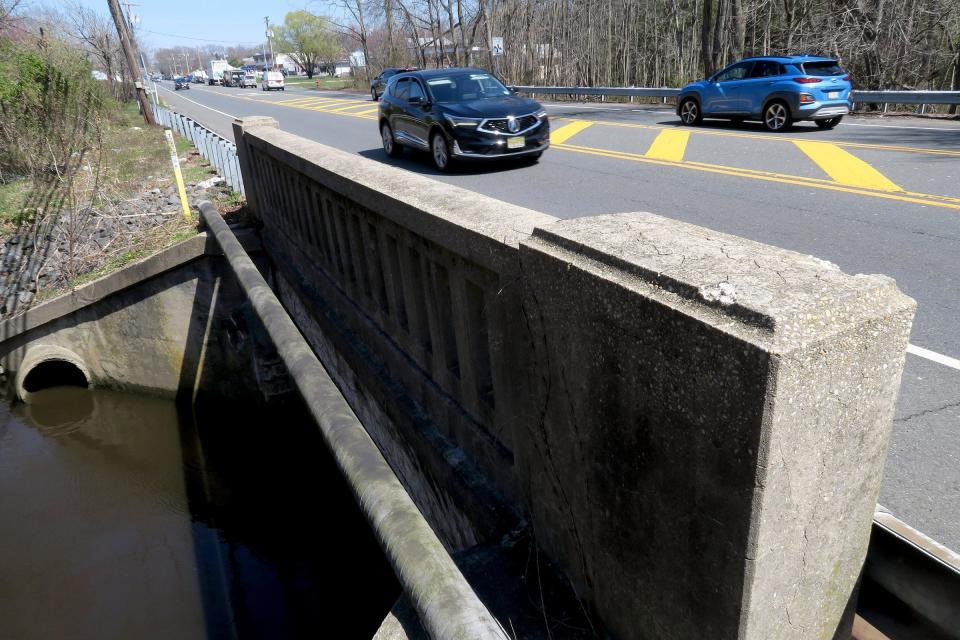
Lowest-rated components: Deck, superstructure and substructure, 4 or poor
The bridge is built in 1931. According to a 2021 letter by U.S. Rep. Chris Smith, R-N.J., requesting funds, “the current structure is in dire need of replacing.” The NJDOT replacement project is estimated to be completed in fall 2026.
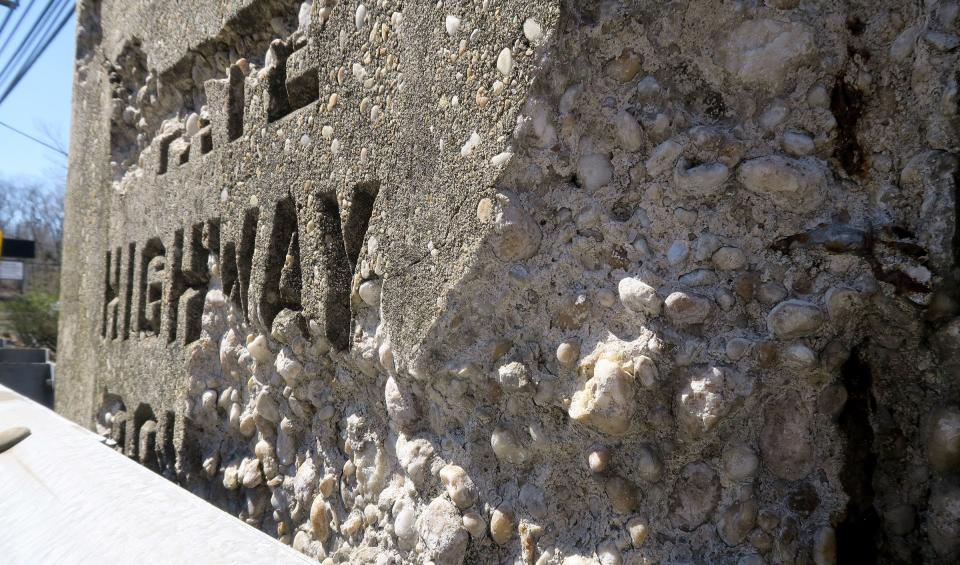
In 2022, it had an average daily traffic of 24,149 vehicles with 4% truck traffic. In 2042, the daily traffic is expected to rise to 29,465 vehicles.
Total estimated project cost according to the NJTPA: $10 million.
Route 36 bridge over Troutmans Creek in Long Branch
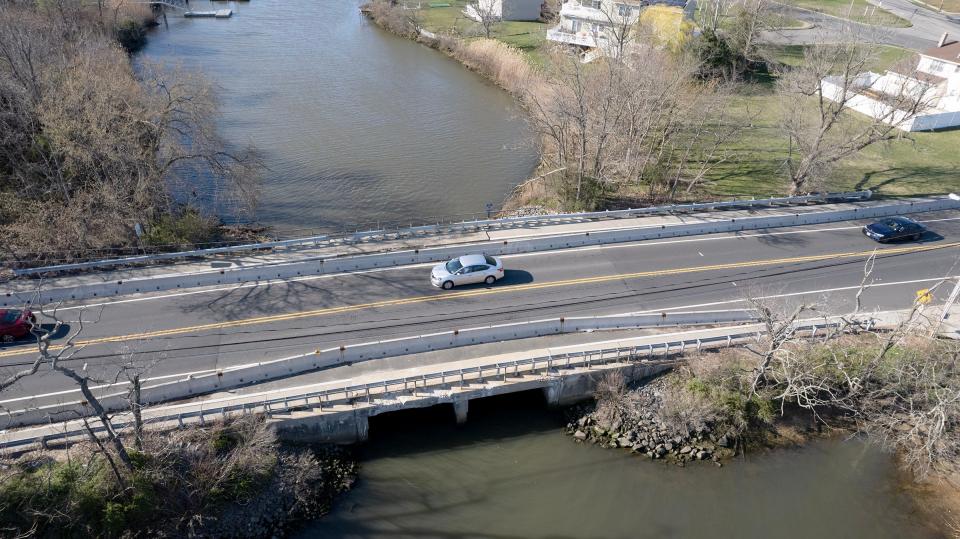
Lowest-rated components: Superstructure, 3 or serious, and substructure, 4 or poor
Built in 1941, the bridge has “outlived its useful life.” Its substructure was rated poor “due to the severe scaling and large spalls with exposed rebars at the pier and abutments within the tidal zone.” (Spalls refers to the pitting or flaking away of load-bearing material.) Its superstructure was rated serious “due to severe corrosion and efflorescence with heavy exfoliation of the steel stringers.” The NJDOT is looking to replace the bridge and construction is estimated to be completed in spring 2027.
In 2020, it had an average daily traffic of 23,588 vehicles with 4% truck traffic. In 2040, the daily traffic is expected to rise to 33,856 vehicles.
Total estimated project cost according to the NJTPA: $8.2 million.
Route 35 northbound bridge over Route 36 northbound and the Garden State Parkway Ramp G in Keyport
Lowest-rated components: Superstructure, 4 or poor
Built in 1931 and reconstructed in 1955, the NJDOT proposes to rehabilitate the “structurally deficient” bridge. The project is in its design phase.
In 2021, it had an average daily traffic of 18,017 vehicles with 4% truck traffic. In 2041, the daily traffic is expected to rise to 22,093 vehicles.
Total estimated project cost according to the NJTPA: $6.8 million.
Forest Resource Education Center Access Road bridge over Toms River
Lowest-rated components: Substructure, 4 or poor
The bridge connecting the Forest Resource Education Center to New Jersey Forest Service Nursey was built in 1950. The project is estimated to be completed by fall 2024.
In 2021, it had an average daily traffic of 55 vehicles with no truck traffic. In 2041, the daily traffic is expected to rise to 66 vehicles.
Construction cost according to the NJDOT Division of Procurement: $2.6 million.
Phalanx Road bridge over the Swimming River Reservoir in Colts Neck and Middletown
Lowest-rated components: Substructure, 4 or poor
Built in 1961, the bridge is in its design phase to explore the potential for replacement.
In 2021, it had an average daily traffic of 7,887 vehicles with 3% truck traffic. In 2041, the daily traffic is expected to rise to 9,624 vehicles.
Cost of the design contract according to the Monmouth County Purchasing Division: $275,000
Every year, Monmouth County can apply for grants under the state’s Transportation Trust Fund. According to resolutions passed in November 2023, three bridges at a cost of about $2 million each were submitted to the state for consideration. They include:
Roberts Road bridge over Hop Brook in Holmdel. Built in 1959, its substructure is rated a 3 or serious. In 2021, it had an average daily traffic of 6,165 vehicles with 3% truck traffic. In 2041, the daily traffic is expected to rise to 7,523 vehicles.
Oak Glen Road bridge over Haystack Brook in Howell. Built in 1946 and reconstructed in 1970, its substructure was rated a 4 or poor. It also has a scour condition of 4, meaning its strength and stability is affected. In 2021, it had an average daily traffic of 1,045 vehicles with 3% truck traffic. In 2041, the daily traffic is expected to rise to 1,250 vehicles.
Baird Road bridge over Millstone River in Millstone. Built in 1955, its substructure was rated a 4 or poor. In 2021, it had an average daily traffic of 855 vehicles with 3% truck traffic. In 2041, the daily traffic is expected to rise to 1,030 vehicles.
The NJDOT is taking the first step — concept development — with two bridges in Monmouth County:
Route 33 bridge over Manalapan Brook in Manalapan. Built in 1927 and reconstructed in 1966, its superstructure and substructure were rated a 4 or poor. It has a scour condition of 3 or major, meaning its strength or stability is seriously affected. Bridge replacement is proposed. In 2021, it had an average daily traffic of 29,357 vehicles with 4% truck traffic. In 2041, the daily traffic is expected to rise to 35,821 vehicles.
Route 35 bridge over the Edgar Felix Bicycle Path in Wall. Built in 1932, its deck was rated a 4 or poor. The NJDOT is exploring the possibility of replacing or rehabilitating the structurally deficient bridge. In 2021, it had an average daily traffic of 25,211 vehicles with 4% truck traffic. In 2041, the daily traffic is expected to rise to 45,533 vehicles.
Which bridges have been improved?
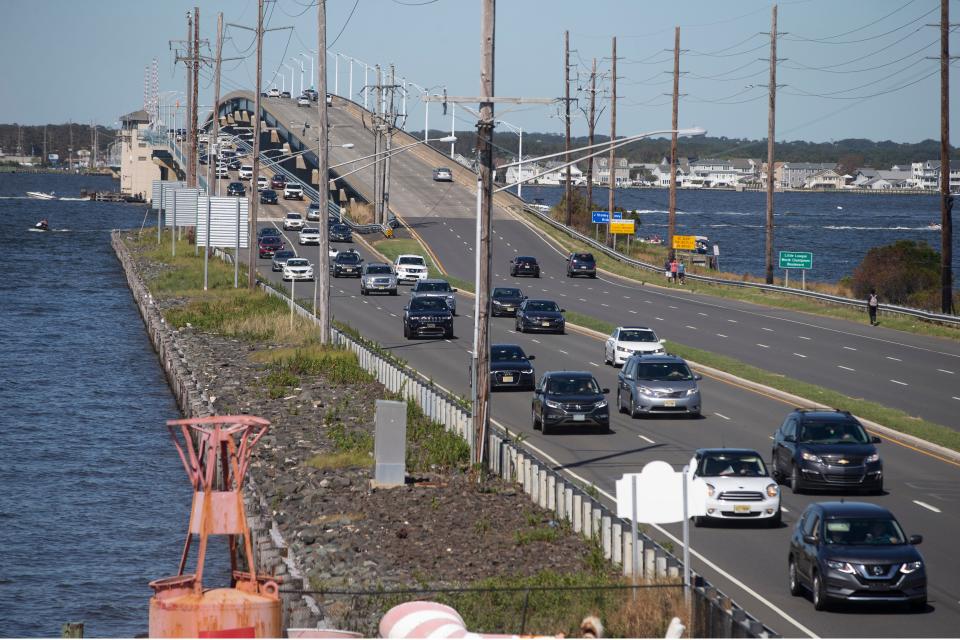
The 10 bridges that have been rehabilitated but have not been updated in the national database include:
The $56.4 million Thomas A. Mathis bridge over Barnegat Bay in Toms River rehabilitation project.
The $33 million Route 35 bridge over Manasquan River in Brielle and Point Pleasant Beach rehabilitation project.
The replacement of Sharon Station Road bridge over Doctors Creek that was part of a $18 million road project in Upper Freehold.
The $5 million Broadway Avenue bridge over Route 35 in Keyport rehabilitation project.
The $4.3 million Old Route 33 bridge over Millstone River in Millstone replacement project.
The $3.5 million Monroe Avenue bridge over Waackaack Creek in Keansburg and Hazlet replacement project.
The $2.9 million Church Road bridge over the north branch of the Metedconk River in Howell and Jackson replacement project.
The $1.9 million Breza Road bridge over Doctor's Creek in Upper Freehold reconstruction project.
The $1.2 million Perrineville Road bridge over Rocky Brook in Millstone reconstruction project.
The $267,000 Leonardville Road bridge over Comptons Creek in Middletown rehabilitation project.
Information came from the USDOT’s National Bridge Inventory, the North Jersey Transportation Planning Authority’s Project Tracker and Transportation Improvement Program budgets, individual project websites, Public Information Center notices, NJDOT and Monmouth County spokespeople, and the procurement databases of the NJDOT, Ocean County and Monmouth County.
Olivia Liu is a reporter covering transportation, Red Bank and western Monmouth County. She can be reached at [email protected].
This article originally appeared on Asbury Park Press: Monmouth, Ocean County bridges that need to be repaired or replaced
